This article has multiple issues. Please help improve it or discuss these issues on the talk page. (Learn how and when to remove these messages)
|
Suburb of Sydney, New South Wales, Australia
| Sydney CBD Sydney, New South Wales | |||||||||||||||
|---|---|---|---|---|---|---|---|---|---|---|---|---|---|---|---|
 Sydney city centre Sydney city centre | |||||||||||||||
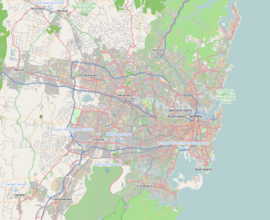 | |||||||||||||||
| Coordinates | 33°52′8″S 151°12′30″E / 33.86889°S 151.20833°E / -33.86889; 151.20833 | ||||||||||||||
| Population | 16,667 (SAL 2021) | ||||||||||||||
| Postcode(s) | 2000 | ||||||||||||||
| Elevation | 58 m (190 ft) | ||||||||||||||
| Area | 2.8 km (1.1 sq mi) | ||||||||||||||
| LGA(s) | City of Sydney | ||||||||||||||
| State electorate(s) | Sydney | ||||||||||||||
| Federal division(s) | Sydney | ||||||||||||||
| |||||||||||||||
The Sydney central business district (CBD) is the historical and main commercial centre of Sydney. The CBD is Sydney's city centre, or Sydney City, and the two terms are used interchangeably. Colloquially, the CBD or city centre is often referred to simply as "Town" or "the City".
The Sydney CBD is Australia's main financial and economic centre, as well as a leading hub of economic activity for the Asia Pacific region. 40.7% of businesses in the CBD fall within the ‘Finance and Financial Services’ or ‘Professional and Business services’ category. It is ranked overall #16 in the 2024 Oxford's Global Cities Index and amongst the top 10 cities in the Human Capital category. Approximately 15% of Sydney's total workforce is employed within the CBD. In 2012, the number of workers operating in the city was 226,972. Based on industry mix and relative occupational wage levels it is estimated that economic activity (GDP) generated in the city in 2015/16 was approximately $118 billion.
Culturally, the city centre is Sydney's focal point for nightlife and entertainment, and is also home to some of the city's most culturally significant buildings and structures.
History
See also: History of Sydney and Liverpool riot of 1916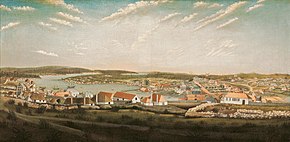
Sydney's history begins in prehistoric times with the occupation of the district by Australian Aboriginals, whose ancestors came to Sydney in the Upper Paleolithic period. Radiocarbon dating suggests that they lived in and around Sydney for at least 30,000 years. Sydney Cove from Port Jackson to Petersham was inhabited by the Cadigal clan. The principal language groups were Darug, Guringai, and Dharawal. The modern history of the city began with the arrival of a First Fleet of British ships in 1788 and the foundation of a penal colony by Great Britain. The area surrounding Port Jackson (Sydney Harbour) was home to several Aboriginal tribes. The "Eora people" are the coastal Aboriginal people of the Sydney district. The name Eora simply means "here" or "from this place", and was used by Local Aboriginal people to describe to the British where they came from.

After arriving to Botany Bay, Captain Arthur Phillip decided that the area was not suitable since it had poor soil, no secure anchorage and no reliable water source. Thus, the fleet moved to the more suitable Port Jackson where a settlement was established at Sydney Cove on 26 January 1788. This date later became Australia's national day, Australia Day. The colony was formally proclaimed by Governor Phillip on 7 February 1788 at Sydney. Sydney Cove offered a fresh water supply and Port Jackson a safe harbour, which Phillip described as: "being without exception the finest Harbour in the World". With the expansion of European settlement large amounts of land was cleared for farming, which resulted in the destruction of Aboriginal food sources. This, combined with the introduction of new diseases such as smallpox, caused resentment within the Aboriginal clans against the British and resulted in violent confrontations.
The oldest legislative body in Australia, the New South Wales Legislative Council, was created in Sydney in 1825 as an appointed body to advise the Governor of New South Wales. The northern wing of Macquarie Street's's Rum Hospital was requisitioned and converted to accommodate the first Parliament House in 1829, as it was the largest building available in Sydney at the time. In 1840 the Sydney City Council was established. Australia's first parliamentary elections were conducted for the New South Wales Legislative Council in 1843.

Macquarie set aside a large portion of land for an Anglican Cathedral and laid the foundation stone for the first St Mary's Catholic Cathedral in 1821. St Andrew's Anglican Cathedral, though more modest in size than Macquarie's original vision, later began construction and, after fire and setbacks, the present St Mary's Catholic Cathedral foundation stone was laid in 1868, from which rose a towering gothic-revival landmark. Religious groups were also responsible for many of the philanthropic activities in Sydney. One of these was the Sydney Female Refuge Society set up to care for prostitutes in 1848. An academy of art formed in 1870 and the present Art Gallery of New South Wales building began construction in 1896. Inspired by the works of French impressionism, artists camps formed around the foreshores of Sydney Harbour in the 1880s. The Romanesque landmark Queen Victoria Building (QVB), designed by George McRae, was completed in 1898 on the site of the old Sydney markets.
In the midst of World War I, on Valentine's Day, riots racked the CBD, in what has come to be known as the Central Station Riots of 1916. A substantial segment of the violence was concentrated in the Central area. These riots involved five thousand military recruits who refused to comply with extraneous parade orders. During the riots, they caused significant damage to buildings. People with "foreign" names were especially targeted. The recruits clashed with soldiers, resulting in the death of Private Ernest William Keefe. Eight people sustained injuries. Because this incident occurred in the middle of the Great War the state discouraged media coverage. Only a fifth of the rioters were court-marshalled. These riots spurred the introduction of lockout laws for pubs after 6 pm. This law was only lifted in 1955.
The early 1960s onwards saw the construction of new modern high-rise skyscrapers in the Sydney CBD, in styles of concrete and glass structures.
Structure
Geography
Main article: Geography of SydneyThe Sydney CBD is an area of very densely concentrated skyscrapers and other buildings, interspersed by several parks such as Hyde Park, The Domain, Royal Botanic Garden and Wynyard Park.
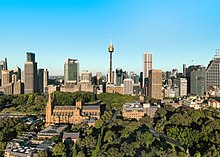
Geographically, its north–south axis runs from Circular Quay in the north to Central railway station in the south. Its east–west axis runs from a chain of parkland that includes Hyde Park, The Domain, Royal Botanic Garden and Farm Cove on Sydney Harbour in the east; to Darling Harbour and the Western Distributor in the west.
The CBD runs along two ridge lines below Macquarie Street and York Streets. Between these ridges is Pitt Street, running close to the course of the original Tank Stream (now tunneled). George Street is the Sydney CBD's main north–south thoroughfare. Bridge Street took its name from the bridge running east–west that once crossed this stream. Martin Place is the banking and commercial heart of Sydney whereas Pitt Street is the retail heart of the city and includes the Pitt Street Mall as well as the Sydney Tower. Macquarie Street is a historic precinct that houses such buildings as the State Parliament House and the Supreme Court of New South Wales.
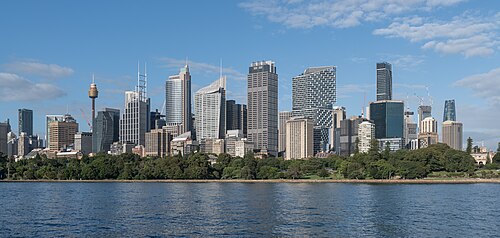
Boundaries

The Geographical Names Board defines the area covering the central business district as the suburb named "Sydney". The formal boundaries of the suburb "Sydney" covers most of the peninsula formed by Cockle Bay in the west and Woolloomooloo Bay in the east. It extends north to Circular Quay, Bennelong Point and Mrs Macquarie's Chair, east to Woolloomooloo Bay and the eastern boundary of the Domain and Hyde Park, south to Goulburn Street just north of Sydney's Chinatown (Haymarket), and west to cover the Darling Harbour area on the western shore of Cockle Bay. However, it does not include the northwestern portion of the peninsula which includes the Barangaroo, The Rocks, Millers Point, Dawes Point and Walsh Bay area, which are formally separate suburbs grouped by the City of Sydney into the "small area" called "The Rocks - Miller's Point - Dawe's Point".
The City of Sydney defines the CBD as comprising two of its ten "villages" – CBD and Harbour Village & Chinatown and CBD South Village.
- CBD and Harbour Village is bounded by the shoreline of Port Jackson in the north, Lincoln Crescent, Sir John Young Crescent, The Domain and College Street in the east, Liverpool Street, Elizabeth Street, Bathurst Street and the Western Distributor in the south, and Darling Harbour in the west.
- Chinatown and CBD South Village is bounded by the Pyrmont Bay Wharf, Darling Harbour, the Western Distributor and Bathurst Street in the north, Elizabeth Street, Liverpool Street, Wentworth Avenue, Elizabeth Street and Chalmers Street in the east, Devonshire Street Tunnel, Lee Street and Railway Square in the south, and the railway line, Pyrmont Street, Murray Street and Pirrama Road in the west.
The postcode zone 2000 is also roughly correlative with the city centre.
Governance

Administratively, the Sydney CBD falls under the authority of the local government area of the City of Sydney. The New South Wales state government also has authority over some aspects of the CBD, in particular through Property NSW.
In the New South Wales state parliament, the seat of "Sydney" covers the city centre together with inner western, southern and eastern suburbs. Independent Alex Greenwich has represented the state seat of Sydney since the 2012 by-election, triggered by the resignation of previous independent Clover Moore, who was the Lord Mayor of Sydney, due to introduced state laws preventing dual membership of state parliament and local council.
In the federal parliament, the seat of "Sydney" covers the city centre together with a larger set of inner western, southern and eastern suburbs, as well as islands in the Sydney Harbour and Lord Howe Island. Australian Labor Party member Tanya Plibersek has represented the federal seat of Sydney since the 1998 Australian federal election.
Precincts
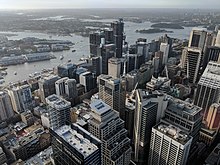
Cultural
See also: Culture of Sydney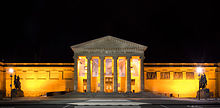
Sydney's cultural centre is compacted within its central business district and inner city ring, due to its nightlife, pedestrian traffic and centrality of notable attractions. There is a large concentration of cultural institutions within the CBD including: the Museum of Sydney, the State Library of New South Wales, the Customs House branch of the City of Sydney Library, the Theatre Royal, the City Recital Hall and the Japan Foundation. There are a total of 19 churches located in the Sydney city centre.
Many other cultural institutions are located at the surrounds of the CBD, such as: the Sydney Opera House and the Museum of Contemporary Art to the north, the Australian Museum and the Art Gallery of New South Wales to the east, the Powerhouse Museum to the west, White Rabbit Gallery and the Haymarket branch of the City of Sydney Library to the south. The lanes and alleyways of Sydney exhibit the culture and arts of the CBD.
Every January during the summer, the city celebrates with the Sydney Festival. Australian and International theatre during the month is also featured, including Aboriginal, and Contemporary.
The Sydney Film Festival is an international event organised every year in June at various venues across the CBD. The festival opened on 11 June 1954 and was held over four days, with screenings at Sydney University. Attendance was at full capacity with 1,200 tickets sold at one guinea each.
Sydney boasts a lively café culture, as well as a club and bar scene distributed throughout the CBD and concentrated in a couple of locations such as Darling Harbour. Although Kings Cross is not technically located within the Sydney CBD, it is accessible via William Street, which runs through Hyde Park and is part of the inner-city region. Oxford Street hosts Sydney's gay scene.
Civic

Macquarie Street is a historic precinct and where many local as well as federal governmental institutions reside. "Macquarie Street" is often used as a metonym for the New South Wales government (the way Whitehall, for example, is a metonym for the British government). Parliament House, Government House, and the Law Courts Building (which houses the Supreme Court of New South Wales) are all located along the street. Federal Government institutions located along this street include the Federal Court of Australia and High Court of Australia, and the headquarters of the Reserve Bank of Australia.
Banking and Commercial

The Sydney CBD is home to some of the largest Australian companies, as well as serving as an Asia-Pacific headquarters for many large international companies. Martin Place is considered to be the financial hub of the CBD and is also where the Australian Securities Exchange is located. In recent years, Martin Place has also been dubbed 'Silicon Place' once global tech giants Amazon, Microsoft, LinkedIn, Expedia and Atlassian.
The financial services industry in particular occupies much of the available office space in the CBD, with companies such as the Westpac, Commonwealth Bank, Citibank, Deutsche Bank, Macquarie Bank, AMP, Insurance Australia Group, Aon, Marsh McLennan, Allianz, HSBC, Axa, ABN Amro, Royal Bank of Canada and Bloomsbury Publishing all having offices.
Transport
Main article: Public transport in SydneySydney's CBD is serviced by commuter rail, light rail, bus and ferry transport.
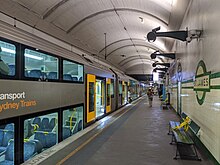
Sydney's main commuter rail hub is Central railway station, which is located to the south of the CBD in Haymarket: it connects services for almost all of the lines in the Sydney Trains network, as well as being the terminus for NSW TrainLink country and inter-urban rail services. From Central, there is a largely-underground CBD rail loop, accessed in both directions via Central, which services five CBD stations (Town Hall, Wynyard, Circular Quay, St James and Museum). This is known as the City Circle. In addition, a separate underground line to Bondi Junction services an additional underground station, Martin Place.
The Inner West Light Rail passes immediately to the south of the CBD, connecting Central to nearby suburbs of Sydney's Inner West. The CBD and South East Light Rail runs north–south through the CBD, connecting Circular Quay with Central and the Eastern Suburbs.

Buses service the CBD along several dozen routes to both inner and more remote suburbs. NightRide is an after-hours bus service that operates between midnight and 5:00 am, with most services running from George Street outside the Sydney Town Hall.
Sydney Ferries operate largely from Circular Quay, on the northern edge of the CBD. There are several wharves (directly beneath the elevated Circular Quay commuter rail station), with Wharf 3 operating exclusively to Manly.
Additionally, the Sydney Metro rapid transit line services the CBD area with four stations (Barangaroo, Martin Place, Gadigal and Central). The inner-city stations were constructed as part of the Sydney Metro City & Southwest project that opened on 19 August 2024 and extended the existing line from Chatswood to Sydenham via the CBD. As of December 2024 construction is underway on a separate rapid transit line to connect the CBD with the secondary centre of Parramatta with a targeted opening date of 2032.
Architecture
Main articles: Architecture of Sydney and List of tallest buildings in Sydney

The Sydney CBD contains many of Australia's tallest skyscrapers, including Governor Phillip Tower, 25 Martin Place and World Tower, the latter consisting predominantly of apartments. It is also home to the Australia Square tower building on George Street, which was the city's tallest building until 1976. As of 2017, the tallest structure is Sydney Tower at 309 m (1,014 ft) which has dominated the city skyline since it was topped out in 1981. In 2016, height limits for buildings were lifted from 235 m (771 ft) to 310 m (1,017 ft).
Heritage conservation has been an ongoing issue for Sydney's city centre since the introduction of green bans in the 1970s and the increasing need for office or living space. Since then, a number of prominent buildings in the CBD have been lost: Anthony Hordern & Sons on George Street, the Regent Theatre also on George Street, Commercial Travelers' Club and Hotel Australia at Martin Place all attracted the ire of Sydneysiders–Sydney Mayor Clover Moore, then the MP for Bligh, even addressed a crowd in Martin Place in 1988 in a futile attempt to save the Regent Theatre from its imminent fate.
Demographics
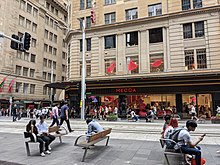
At the 2021 census, the population of the Sydney CBD was recorded as 16,667. International students account for 32% of Sydney CBD residents.
Australia-born individuals make up 22.3% of the CBD's population. The most common countries of birth other than Australia were Indonesia (12.9%), Thailand (12.4%), China (9.7%), India (3.5%) and South Korea (3.1%). Aboriginal and/or Torres Strait Islander people made up 0.3% of the population.
Culturally, residents in the CBD have diverse ancestries, with Chinese, Thai, English, Indonesian, and Korean being the most common. Religious affiliations are equally diverse, with the largest group reporting 'No Religion' (36.1%), followed by Buddhism (21.4%) and Catholicism (13.7%). 99.2% of dwellings were flats or apartments. 72.0% were rented and 24.2% were owned outright or with a mortgage in 2021.
References
- Australian Bureau of Statistics (28 June 2022). "Sydney Central Business District (suburb and locality)". Australian Census 2021. Retrieved 20 August 2022.

- "When Sydney overtook Melbourne as Australia's financial centre". Australian Financial Review. 18 November 2021.
- Australia, Tourism (18 November 2021). "Sydney Industry Sectors - Business Events - Tourism Australia". businessevents.australia.com. Archived from the original on 19 June 2023. Retrieved 19 June 2023.
- "Commission into the Future of the Sydney's Central Business District (CBD)–Challenges and opportunities" (PDF). ARUP Committee for Sydney. 9 February 2021.
- "Sydney ranked among the top twenty cities around the world based on a huge range of indicators on Oxford Economics' inaugural Global Cities Index". Time Out. 22 May 2024.
- "The 10 cities leading in human capital in 2024". Oxford Economics. 6 June 2024.
- Terrill, Marion; Batrouney, Hugh; Hourani, Diana; Ha, James (November 2018). "2.1". Remarkably adaptive: Australian cities in a time of growth (PDF) (Report) (2018-13 ed.). Grattan Institute. ISBN 978-0-6483311-4-8.
- "CBD and Harbour". City Of Sydney. 2012. Archived from the original on 5 August 2020. Retrieved 29 April 2019.
- "Australia's economic activity heavily concentrated in Sydney and Melbourne". taxpayer.com.au. 21 August 2014. Archived from the original on 1 April 2015. Retrieved 31 March 2015.
- "Australia's second largest city, one of the most important ports in the South Pacific and the home of many iconic cultural institutions". World Cities Culture Forum. 2024.
- Attenbrow, Val (2010). Sydney's Aboriginal Past: Investigating the Archaeological and Historical Records. Sydney: UNSW Press. pp. 152–153. ISBN 978-1-74223-116-7. Archived from the original on 23 September 2023. Retrieved 11 November 2013.
- Macey, Richard (2007). "Settlers' history rewritten: go back 30,000 years". Sydney Morning Herald. Archived from the original on 2 July 2018. Retrieved 5 July 2014.
- "Cook's landing site". Department of Planning & Environment. 2014. Archived from the original on 5 November 2013. Retrieved 5 July 2014.
- "Aboriginal people and place |". www.sydneybarani.com.au. Archived from the original on 26 April 2020. Retrieved 19 June 2023.
- "Geographical Names Register Extract - Sydney". Place Name Search. Geographical Names Board of New South Wales. Archived from the original on 18 September 2018. Retrieved 25 April 2019.
- Peter Hill (2008) p.141-150
- "Arthur Phillip | State Library of New South Wales". Archived from the original on 3 February 2013. Retrieved 14 July 2011.
- "Aboriginal People of the Sydney Region". Australian Association of Bush Regenerators. Archived from the original on 19 July 2008. Retrieved 11 May 2013.
- "Parliament House - City of Sydney". Archived from the original on 6 March 2011. Retrieved 17 February 2011.
- "AEC redirection page". Archived from the original on 1 June 2011. Retrieved 23 December 2020.
- "QVB". Archived from the original on 24 November 2020. Retrieved 23 December 2020.
- SYDNEY FEMALE REFUGE SOCIETY Archived 12 April 2024 at the Wayback Machine. (8 March 1864). Empire (Sydney, NSW : 1850 – 1875), p. 5. Retrieved 5 February 2019
- "AGNSW - History of the Art Gallery of New South Wales". www.artgallery.nsw.gov.au. Archived from the original on 11 September 2002.
- "Artists' camps | the Dictionary of Sydney". Archived from the original on 20 January 2021. Retrieved 23 December 2020.
- "About". www.qvb.com.au. Archived from the original on 20 June 2023. Retrieved 20 June 2023.
- "The Central Station Riots of 1916". historyofsydney.com.au. 30 April 2017. Archived from the original on 20 June 2023. Retrieved 29 July 2023.
- "The Central Station Riots of 1916". History of Sydney. Archived from the original on 21 November 2018. Retrieved 21 November 2018.
- "The Significance of Martin Place". Reserve Bank of Australia.
- "Parliament House | The Dictionary of Sydney". dictionaryofsydney.org. Archived from the original on 19 June 2023. Retrieved 19 June 2023.
- "NSW GNB - Sydney (suburb)". Archived from the original on 4 September 2019. Retrieved 4 September 2019.
- Detailed Suburb Report for Sydney Archived 16 January 2021 at the Wayback Machine, Microburbs
- Sydney - About the profile areas Archived 1 November 2017 at the Wayback Machine, ID.com.au
- "Our Villages". City of Sydney Data Hub.
- "Home". City of Sydney. Archived from the original on 19 February 2011. Retrieved 6 April 2013.
- "Property Asset Utilisation". Audit Office of New South Wales. 7 October 2018. Archived from the original on 19 June 2023. Retrieved 19 June 2023.
- "Clover Moore set to leave NSW parliament - 9News". www.9news.com.au. 3 April 2012. Archived from the original on 20 June 2023. Retrieved 20 June 2023.
- "About". www.tanyaplibersek.com. Archived from the original on 12 June 2023. Retrieved 20 June 2023.
- "Bathurst Street, Sydney". Pavo Properties. Archived from the original on 19 June 2023. Retrieved 19 June 2023.
- "Churches". sydneyorgan.com. Archived from the original on 22 June 2015. Retrieved 22 June 2015.
- "In Between Two Worlds | City Art Sydney". www.cityartsydney.com.au. Archived from the original on 19 June 2023. Retrieved 19 June 2023.
- Kaufman, Tina (May 2003). "Looking Back, Looking Forward: the Sydney Film Festival at 50". Senses of Cinema. 26. Senses of Cinema Inc. Archived from the original on 15 April 2005. Retrieved 25 April 2005.
- "Sydney City". Destination New South Wales. Archived from the original on 9 April 2013. Retrieved 6 April 2013.
- "Gay Sydney, Australia | The Essential LGBT Travel Guide!". 6 March 2019. Archived from the original on 19 June 2023. Retrieved 19 June 2023.
- "The city at a glance". City of Sydney. 9 April 2020. Archived from the original on 7 September 2023. Retrieved 19 June 2023.
- "The Significance of Martin Place". Reserve Bank of Australia.
- "ASX finds Martin Place home in coup for finance strip". realcommercial.com.au. 21 June 2024.
- "Sydney's Martin Place now tech hub for Amazon, LinkedIn and more". CRN. 13 November 2017.
- "Heritage-listed home of Burberry and Atlassian gets $16.6m facelift". The Sydney Morning Herald. 23 March 2022.
- "Australia Archived 16 February 2017 at the Wayback Machine." ABN Amro. Retrieved 15 February 2017.
- "Contact Us Archived 13 October 2012 at the Wayback Machine." Bloomsbury Publishing. Retrieved 14 October 2012. "Bloomsbury Publishing Pty Ltd. Level 14 309 Kent St Sydney NSW 2000 Australia"
- "The Eastern Suburbs Railway". Transport Heritage NSW. 29 July 2019. Archived from the original on 3 April 2023. Retrieved 19 June 2023.
- Late night services Archived 13 April 2018 at the Wayback Machine Transport for NSW
- "Welcome Aboard! Sydney Metro City now open | Sydney Metro". www.sydneymetro.info. Retrieved 29 December 2024.
- "West project overview | Sydney Metro". www.sydneymetro.info. Retrieved 29 December 2024.
- Lambert, Olivia (14 July 2016). "Sydney allows taller skyscrapers while Melbourne attempts to curb density". News.com.au. Archived from the original on 16 January 2021. Retrieved 30 October 2020.
- "PS Spotlight: Exhibition projects insight into past of city's picture theatres". 1 September 2017. Archived from the original on 21 December 2019. Retrieved 21 December 2019.
- ^ Australian Bureau of Statistics (28 June 2022). "Sydney". 2021 Census QuickStats. Retrieved 5 December 2022.

- Terrill, Marion; Batrouney, Hugh; Hourani, Diana; Ha, James (November 2018). "2.1". Remarkably adaptive: Australian cities in a time of growth (PDF) (Report) (2018-13 ed.). Grattan Institute. ISBN 978-0-6483311-4-8.
External links
- [REDACTED] Media related to Central Business District, Sydney at Wikimedia Commons
| Suburbs and localities within the City of Sydney | |
|---|---|
| Suburbs |
|
| Localities | |
| List of Sydney suburbs | |
| Capital city central business districts of Australia | ||||||||||
|---|---|---|---|---|---|---|---|---|---|---|
| Sydney central business district historical attractions | |
|---|---|
| Government buildings |
|
| Commercial buildings |
|
| Residential buildings | |
| Churches and other places of worship | |
| Pubs and hotels | |
| Transport infrastructure | |
| Cultural institutions and parklands | |
| Other significant historical features | |